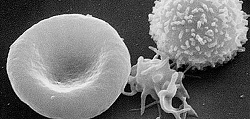• Specialty which deals with populations and comprises those doctors who try to measure the needs of the population, both … Read More »
BLOOD GROUPS
Types: Ø ABO system Ø Rh System Ø ABO system Ø Based upon A and B antigens (agglutinogens) present on … Read More »
Anticlotting Mechanisms
Anticlotting mechanisms include intravascular anticoagulants, thrombin removal from blood, heparin and clot lysis. These are explained one by one, followed … Read More »
Hemostasis
Prevention of blood loss Steps: i.Vascular spasm ii.Formation of platelet plug iii.Formation of blood clot as a result of blood … Read More »
Current of Injury in ECG
Flow of current from damaged area to normal area of heart between heart beats is called current of injury Damaged … Read More »
ELECTROCARDIOGRAM (ECG)
Graphic record of summated electrical activity of heart obtained by electrodes placed on body surface. Electrocardiograph is the instrument to … Read More »
Action Potential
Brief, rapid, large and reversible change in resting membrane potential of an excitable cell during which the membrane potential reverses … Read More »
Skeletal Muscle
A muscle is an excitable tissue having ability to contract. There are three types of muscles: 1) Skeletal muscle 2) … Read More »
Cardiac Cycle
Cardiac events appearing from the beginning of one heart beat to the beginning of next heart beat and repeating themselves … Read More »
Regulation of Heart Rate, Rhythm & Contractility
Heart is innervated by both divisions of autonomic nervous system (ANS) i.e. sympathetic & parasympathetic. • Nervous stimulation is not … Read More »
 howMed Know Yourself
howMed Know Yourself

